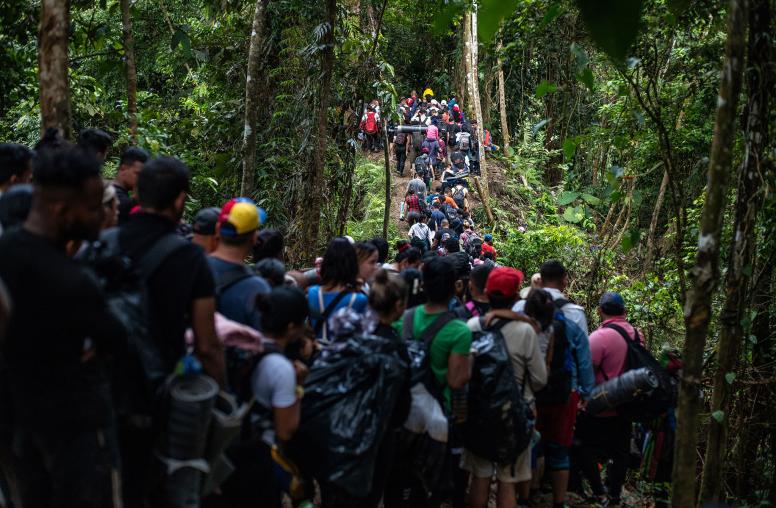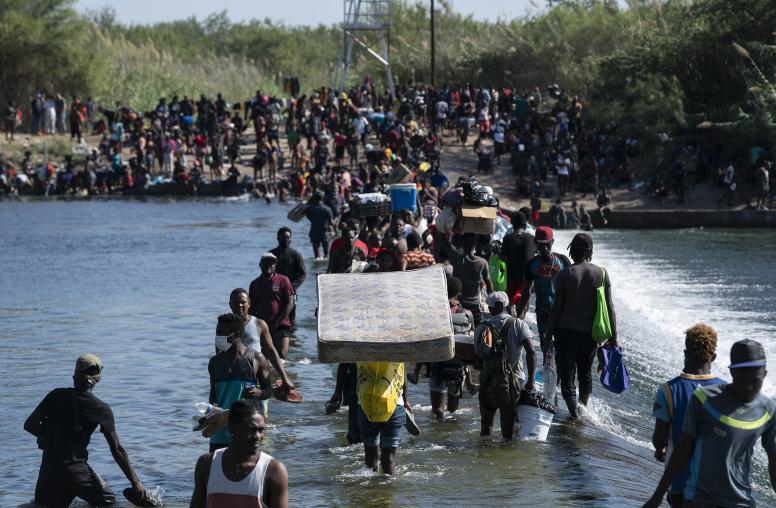Amid Global Coronavirus Outbreak, What About Refugees?
As countries try to mitigate the spread of COVID-19, the health of displaced persons cannot be overlooked.
With COVID-19 officially labelled a global pandemic, the focus for many countries has turned toward protecting their most vulnerable populations. But what about camps for refugees and internally displaced persons (IDPs)? Many camps lack the resources to maintain their already poor infrastructure, and the threat of a COVID-19 outbreak puts millions of displaced persons in a dangerous position. USIP’s Fouad Pervez looks at the unique risks that COVID-19 poses to refugees and IDPs, the impact an outbreak among these groups would have on the global pandemic, and what the international community can do to protect them.

What makes refugees and displaced persons such high-risk populations for outbreaks of contagious diseases?
These populations are at incredibly high risk for outbreaks of contagious diseases for several reasons. Start with their background: refugees and displaced persons likely fled from conflict, so they are starting off in less than ideal health and likely have not had access to adequate health services. Additionally, these populations have possibly dealt with poor nutrition prior to entering the camps.
Then consider their current living conditions: due to overcrowding and poor infrastructure, camps are hardly sanitary places. If you look at the normal ways to prevent an outbreak of an infectious disease like COVID-19—such as washing your hands, engaging in social distancing, ensuring good hygiene, and checking in with health providers the second you are concerned about your condition—none are readily available in these camps.
Finally, even in the best-case scenario, these populations are often not a priority for political leaders. As such, they likely will not get the attention they require. We’ve seen examples of this already, as countries experiencing outbreaks are temporarily suspending services to refugee camps. This is a very unfortunate and short-sighted response, as these camps need services now more than ever.
Beyond the direct public health implications, what effect can an unmitigated outbreak have on a conflict?
As my colleague Chris Bosley and I have noted before, a poor response to an outbreak like COVID-19 can create additional grievances for populations against governments. It can also severely damage an economy, as countries will have to shut down entirely to stop the spread of the virus. Nonstate actors can prey on these grievances to create discord and conflict, undermine stability, or slow down a peace process. Without adequate government responses, it’s not hard to envision an increase in conflict and destabilization in fragile regions. Conversely, we also know that the containment of infectious diseases, such as Ebola in the Democratic Republic of the Congo, is negatively impacted by already existing political violence.
And beyond those already in camps, we need to also think about those attempting to flee conflict right now. Turkey, for instance, has stopped preventing Syrian refugees from leaving their country and entering neighboring countries. Meanwhile, Syria has closed at least one border crossing, while Greece has tightened security on their side of the Turkish border. We need to pay careful attention to these border politics in this crisis, because it could lead to vulnerable populations shifting between countries very easily or not being allowed in even though they are in extreme danger. It’s a balancing act, and the best approach should involve accounting for their safety while finding ways to provide them care.
What’s the risk of undue stigma on refugees and IDPs during a global outbreak, such as COVID-19?
If these camps get hit with an outbreak, which is fairly likely given all the conditions present, they become an easy target for political leaders wanting to deflect blame from themselves. Leaders could claim the virus came from refugees, even if untrue or even if a spread is entirely due to camps being poorly resourced, further stigmatizing this population. This can create a vicious feedback loop where refugees and displaced persons are further marginalized, resulting in worsening conditions in the camps and higher susceptibility to outbreaks—which can then be used by political leaders looking to further scapegoat displaced persons.
In addition to refugees, we should be wary of any stigmatization by governments of groups of people over the spread of the virus. There is little doubt leaders could use COVID-19 in an attempt to turn their country’s populations against any number of marginalized groups—whether they are refugees, ethnic or religious minorities, or political opponents. Refugees and IDPs are particularly at risk of this, given the conditions they face, but we should be critical of governments partaking in any such actions. This is a global pandemic, and while there were many mistakes made along the way, no particular groups of people should be blamed for its spread.
What can the international community do to prevent it? What are the most effective actors in mitigating or preventing an outbreak?
Ideally, countries would work through multilateral or regional institutions—particularly the World Health Organization (WHO), the U.N., the International Committee of the Red Cross, and other NGOs—to formulate a coordinated response to the pandemic and provide services for these camps.
It’s in everyone’s best interest to protect displaced persons from an outbreak like COVID-19—primarily because it is the right thing to do, but also because it’s important for preventing contagious diseases from spreading. These camps have staff that go home every day, and if they are infected, viruses can easily spread. Refugees and IDPs could also seek out work and leave the camps for periods of time, so they are obvious vectors to spread viruses. Simply put, the international community has a responsibility to provide services to these vulnerable populations to slow down the spread of all diseases, not just COVID-19.
We cannot do this alone—every country is affected, and we need to be cautious of looking inwards too much. Given the global nature of COVID-19, our neglect of vulnerable populations risks a greater spread of the virus. The United States and other global powers should not limit their commitments to these camps and should do their best to influence donors to follow their lead. These camps are severely under-resourced, and social distancing and quarantines are not really possible. But better health care and better living conditions would go a long way in preventing infectious diseases from spreading.
Through the WHO and the U.N., we can run education campaigns in the camps to teach refugees and IDPs how to minimize the risks of getting COVID-19. To be clear, this will not be particularly effective unless we improve the camps themselves, as teaching them to wash their hands for 30 seconds does no good if they do not have access to clean water. These same organizations, in conjunction with the host governments, could also run similar programs to educate the public about the risk refugees face from COVID-19 and the need to help them, so as to minimize stigmatization and to encourage support of the camps.
This should be a moment of reflection about refugee camps overall—the terrible conditions make them particularly susceptible to diseases, posing further danger to people who have already fled conflict.

